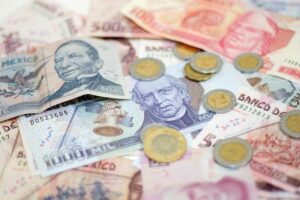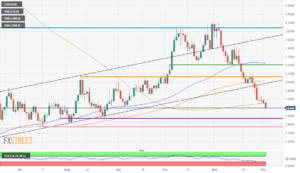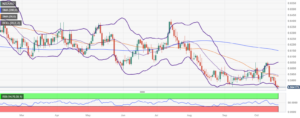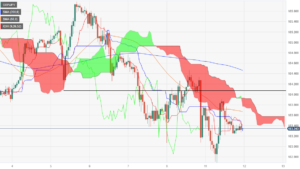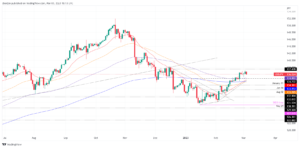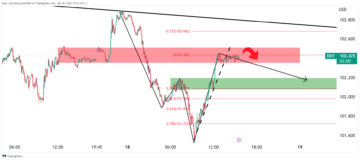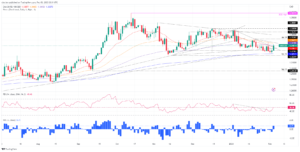- The Canadian Dollar sheds weight on Tuesday, walks back Monday gains.
- Economic data from Canada remains absent on the calendar.
- Crude Oil is plunging as markets reassess slowing global growth, causing demand declines to outpace production cuts.
The Canadian Dollar (CAD) fell back on Tuesday as markets shuffled their stance following US Consumer Price Index (CPI) inflation figures that exactly met market expectations, pointing to dwindling growth looking forward.
Canada sees little to no meaningful data on the economic calendar this week, leaving the CAD to get dragged around the charts by the broader market. Crude Oil markets are seeing broad declines on declining demand concerns, further pressuring the Loonie.
Daily Digest Market Movers: US CPI meets expectations, price growth slowly cools
- The Canadian Dollar saw losses across the board on Tuesday, with slight to moderate declines against all but one of the CAD’s major currency peers.
- The CAD’s weakest performance sees it down half of a percent against the Japanese Yen (JPY) and four-tenths of a percent against the Swiss Franc (CHF).
- The Loonie’s ‘strongest’ performance is against the Australian Dollar (AUD), mostly flat against the Antipodean, with a close second going to a tenth of a percent decline against the post-CPI US Dollar (USD).
- US Consumer Price Index (CPI) inflation met the Street’s expectations across the board, with headline annualized CPI inflation ticking down from 3.2% to 3.1% and the MoM figure ticking up slightly from a flat 0.0% to 0.1%.
- Core CPI inflation (headline inflation less volatile food and energy prices) held steady at 4% for the YoY figure, with November’s MoM Core CPI printing slightly higher at 0.3% versus October’s 0.2%.
- Crude Oil markets are taking a leg down in the face of declining price growth from the US, adding further weight to ongoing energy market concerns about declining fossil demand eclipsing global production cuts, specifically from the Organization of the Petroleum Exporting Countries (OPEC).
- US West Texas Intermediate (WTI) Crude Oil slips back to $69.00 per barrel.
- The Canadian Dollar is getting dragged down in lockstep with deflating Crude Oil bids.
- Next up for markets will be the Federal Reserve’s (Fed) Monetary Policy Statement and updates to its Interest Rate Projections, both due on Wednesday at 19:00 GMT and to be followed up by a Press Conference at 19:30 GMT.
Canadian Dollar price today
The table below shows the percentage change of Canadian Dollar (CAD) against listed major currencies today. Canadian Dollar was the strongest against the Australian Dollar.
| USD | EUR | GBP | CAD | AUD | JPY | NZD | CHF | |
| USD | -0.29% | -0.11% | 0.08% | 0.07% | -0.41% | -0.17% | -0.34% | |
| EUR | 0.29% | 0.19% | 0.37% | 0.36% | -0.13% | 0.12% | -0.05% | |
| GBP | 0.10% | -0.19% | 0.19% | 0.18% | -0.30% | -0.05% | -0.23% | |
| CAD | -0.08% | -0.36% | -0.20% | 0.02% | -0.49% | -0.25% | -0.42% | |
| AUD | -0.07% | -0.36% | -0.18% | 0.02% | -0.50% | -0.25% | -0.44% | |
| JPY | 0.40% | 0.11% | 0.30% | 0.49% | 0.50% | 0.24% | 0.06% | |
| NZD | 0.16% | -0.12% | 0.06% | 0.26% | 0.25% | -0.25% | -0.18% | |
| CHF | 0.33% | 0.05% | 0.23% | 0.44% | 0.43% | -0.08% | 0.17% |
The heat map shows percentage changes of major currencies against each other. The base currency is picked from the left column, while the quote currency is picked from the top row. For example, if you pick the Euro from the left column and move along the horizontal line to the Japanese Yen, the percentage change displayed in the box will represent EUR (base)/JPY (quote).
Technical Analysis: Canadian Dollar trips over slumping Crude Oil, sends USD/CAD back over 1.3600
The Canadian Dollar (CAD) looks for the basement on Tuesday, backsliding across the board and shedding weight against all of its major currency peers.
The USD/CAD has regained the 1.3600 handle after catching a topside break of consolidation between the 50-hour and 200-hour Simple Moving Averages (SMA) in the 1.3580 to 1.3560 zone.
The USD/CAD is toying with last week’s highs near 1.3620 after rebounding from familiar near-term lows at 1.3550. The pair is at risk of hardening into a sideways consolidation range, but the US Dollar (USD) is set up for further breakouts following central bank action on Wednesday.
The USD/CAD continues to hold chart territory north of the 200-day SMA just above the 1.3500 handle, keeping bids above the major moving average, but immediate topside momentum remains constrained by the 50-day SMA near 1.3700.
USD/CAD Hourly Chart
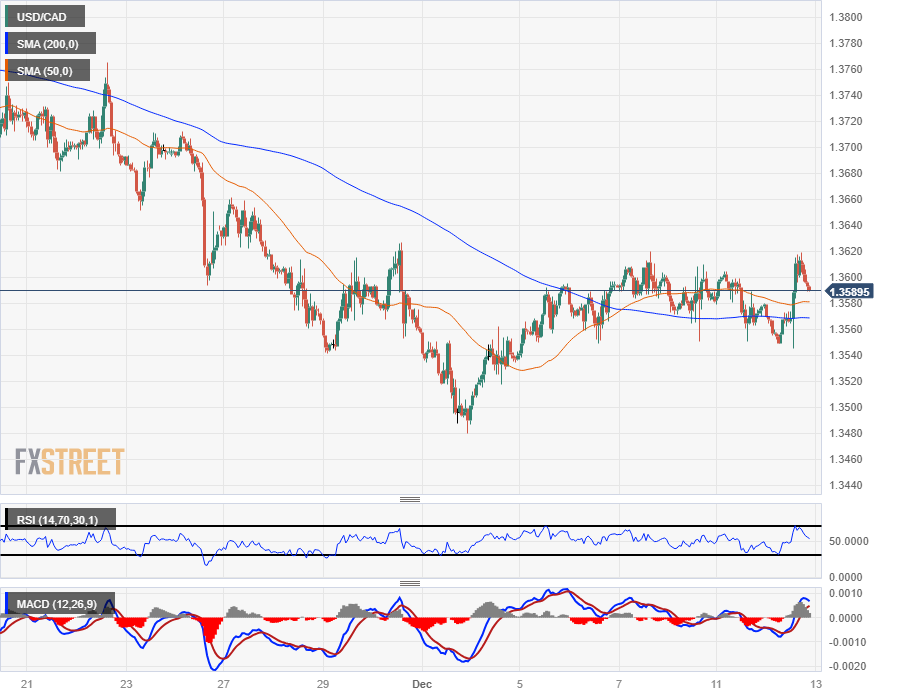
USD/CAD Daily Chart

Canadian Dollar FAQs
The key factors driving the Canadian Dollar (CAD) are the level of interest rates set by the Bank of Canada (BoC), the price of Oil, Canada’s largest export, the health of its economy, inflation and the Trade Balance, which is the difference between the value of Canada’s exports versus its imports. Other factors include market sentiment – whether investors are taking on more risky assets (risk-on) or seeking safe-havens (risk-off) – with risk-on being CAD-positive. As its largest trading partner, the health of the US economy is also a key factor influencing the Canadian Dollar.
The Bank of Canada (BoC) has a significant influence on the Canadian Dollar by setting the level of interest rates that banks can lend to one another. This influences the level of interest rates for everyone. The main goal of the BoC is to maintain inflation at 1-3% by adjusting interest rates up or down. Relatively higher interest rates tend to be positive for the CAD. The Bank of Canada can also use quantitative easing and tightening to influence credit conditions, with the former CAD-negative and the latter CAD-positive.
The price of Oil is a key factor impacting the value of the Canadian Dollar. Petroleum is Canada’s biggest export, so Oil price tends to have an immediate impact on the CAD value. Generally, if Oil price rises CAD also goes up, as aggregate demand for the currency increases. The opposite is the case if the price of Oil falls. Higher Oil prices also tend to result in a greater likelihood of a positive Trade Balance, which is also supportive of the CAD.
While inflation had always traditionally been thought of as a negative factor for a currency since it lowers the value of money, the opposite has actually been the case in modern times with the relaxation of cross-border capital controls. Higher inflation tends to lead central banks to put up interest rates which attracts more capital inflows from global investors seeking a lucrative place to keep their money. This increases demand for the local currency, which in Canada’s case is the Canadian Dollar.
Macroeconomic data releases gauge the health of the economy and can have an impact on the Canadian Dollar. Indicators such as GDP, Manufacturing and Services PMIs, employment, and consumer sentiment surveys can all influence the direction of the CAD. A strong economy is good for the Canadian Dollar. Not only does it attract more foreign investment but it may encourage the Bank of Canada to put up interest rates, leading to a stronger currency. If economic data is weak, however, the CAD is likely to fall.
- SEO Powered Content & PR Distribution. Get Amplified Today.
- PlatoData.Network Vertical Generative Ai. Empower Yourself. Access Here.
- PlatoAiStream. Web3 Intelligence. Knowledge Amplified. Access Here.
- PlatoESG. Carbon, CleanTech, Energy, Environment, Solar, Waste Management. Access Here.
- PlatoHealth. Biotech and Clinical Trials Intelligence. Access Here.
- Source: https://www.fxstreet.com/news/canadian-dollar-gets-dragged-down-on-tuesday-as-crude-oil-slumps-us-cpi-inflation-meets-expectations-202312121633
- :has
- :is
- :not
- $UP
- 1
- 19
- 2%
- 30
- 31
- 32
- 36
- 41
- a
- About
- above
- absent
- across
- Action
- actually
- adding
- adjusting
- After
- against
- aggregate
- All
- along
- also
- always
- an
- analysis
- and
- Animate
- annualized
- Another
- ARE
- around
- AS
- Assets
- At
- attract
- Attracts
- AUD
- Australian
- Australian dollar
- average
- back
- Balance
- Bank
- bank of canada
- Banks
- base
- BE
- been
- being
- below
- between
- Biggest
- board
- BoC
- both
- Box
- Break
- breakouts
- broad
- broader
- but
- by
- CAD
- Calendar
- CAN
- Canada
- Canadian
- Canadian Dollar
- capital
- capital controls
- case
- causing
- central
- Central Bank
- Central Banks
- change
- Changes
- Chart
- Charts
- chf
- Close
- Column
- Concerns
- conditions
- Conference
- consolidation
- consumer
- consumer price index
- consumer sentiment
- content
- continues
- controls
- Core
- countries
- CPI
- credit
- cross-border
- crude
- Crude oil
- currencies
- Currency
- cuts
- daily
- data
- Decline
- Declines
- Declining
- Demand
- difference
- Digest
- direction
- displayed
- does
- Dollar
- down
- driving
- due
- each
- easing
- Economic
- economy
- employment
- encourage
- ends
- energy
- Energy Market
- energy prices
- EUR
- Euro
- everyone
- exactly
- example
- expanded
- expectations
- export
- exports
- Face
- factor
- factors
- Fall
- Falls
- familiar
- FAQ
- Fed
- Federal
- Federal Reserve’s
- Figure
- Figures
- flat
- followed
- following
- food
- For
- foreign
- foreign investment
- Former
- Forward
- fossil
- Franc
- from
- further
- Gains
- gauge
- GDP
- generally
- get
- getting
- Global
- GMT
- goal
- Goes
- going
- good
- greater
- Growth
- had
- handle
- Have
- headline
- Health
- Held
- higher
- Highs
- hold
- Horizontal
- However
- HTTPS
- if
- immediate
- Impact
- impacting
- imports
- in
- include
- Increases
- index
- Indicators
- inflation
- inflation figures
- inflows
- influence
- influencing
- interest
- INTEREST RATE
- Interest Rates
- Intermediate
- into
- investment
- Investors
- IT
- ITS
- Japanese
- Japanese Yen
- JPY
- just
- Keep
- keeping
- Key
- key factor
- largest
- Last
- lead
- leading
- leaving
- left
- LEND
- less
- Level
- likelihood
- likely
- Line
- Listed
- little
- local
- looking
- LOOKS
- losses
- Lows
- lucrative
- Main
- maintain
- major
- major currency
- manufacturing
- map
- Market
- market sentiment
- Markets
- May..
- meaningful
- Meets
- met
- moderate
- Modern
- module
- mom
- Momentum
- Monday
- Monetary
- Monetary Policy
- money
- more
- mostly
- move
- Movers
- moving
- moving average
- moving averages
- Near
- negative
- no
- North
- of
- Oil
- oil markets
- oil price
- on
- ONE
- ongoing
- only
- opec
- opposite
- or
- organization
- Other
- over
- pair
- partner
- peers
- per
- percent
- percentage
- performance
- Petroleum
- pick
- picked
- Place
- plato
- Plato Data Intelligence
- PlatoData
- plunging
- policy
- positive
- press
- price
- Prices
- printing
- Production
- projections
- put
- quantitative
- Quantitative Easing
- quote
- range
- Rate
- Rates
- relatively
- relaxation
- Releases
- remains
- represent
- reserves
- result
- Rises
- Risk
- Risky
- ROW
- saw
- Second
- seeing
- seeking
- sees
- sends
- sentiment
- Services
- set
- setting
- Shows
- sideways
- significant
- Simple
- since
- Slowing
- Slowly
- Slump
- SMA
- So
- specifically
- stance
- starts
- Statement
- steady
- strong
- stronger
- strongest
- such
- supportive
- Swiss
- table
- taking
- tend
- tends
- territory
- texas
- that
- The
- their
- this
- thought
- ticking
- tightening
- times
- to
- today
- top
- trade
- Trading
- traditionally
- Tuesday
- Updates
- us
- US CPI
- US Dollar
- US economy
- USD
- USD/CAD
- use
- value
- Versus
- volatile
- walks
- was
- Wednesday
- weight
- West
- whether
- which
- while
- will
- with
- WTI
- Yen
- you
- zephyrnet

